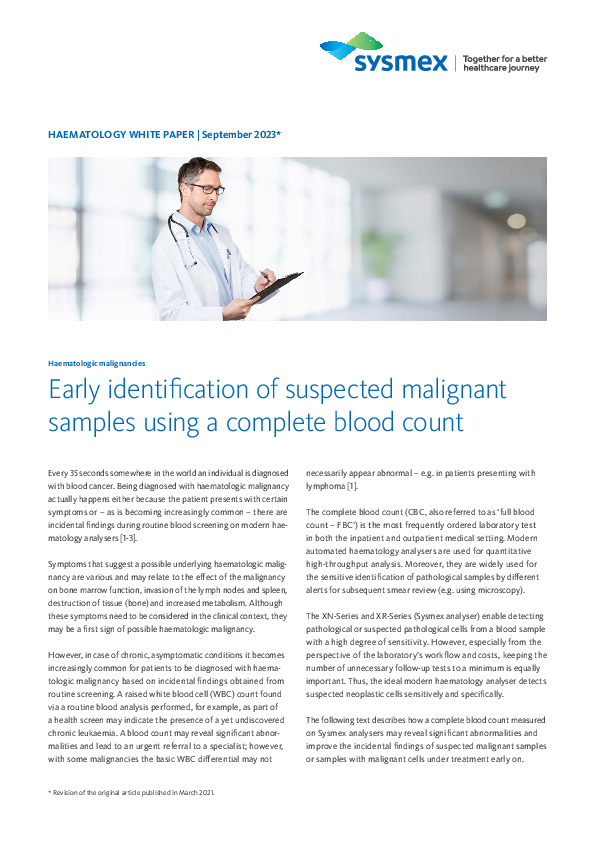Incidental findings of haematologic malignancies
Recognize the early signs of leukaemia already from standard blood cell count analysis
The complete blood cell count (CBC) is the most frequently ordered laboratory test in both the inpatient and outpatient medical setting. Modern automated haematology analysers are used for high-throughput analyses of complete blood counts. Moreover, these analysers are also widely used for the sensitive identification of pathologic samples, with conspicuous results indicated by different alerts for subsequent smear review, e.g. under a microscope.
Sysmex’s XN-Series analysers enable to detect pathologic cells in a blood sample with a high degree of sensitivity, so the blood count performed on such a state-of-the-art haematology analyser offers the opportunity of diagnosing many haematologic malignancies early, which would otherwise have remained unrecognized. The fact that every minute somewhere in the world an individual is diagnosed with blood cancer shows how important this is.
Benefits of analysing your blood samples on an XN-Series analyser
- Early findings of haematologic malignancies due to the sensitive detection of various pathologic cells.
- Very sensitive detection of nucleated red blood cells indicating stress or damage to the bone marrow – performed with every blood count.
- Use of best-in-class proprietary algorithms on our modern haematology analysers flagging sensitively and specifically immature precursor cells – with every differential blood count.
- A new score for the timely detection of potentially unrecognized cases of chronic myelomonocytic leukaemia (CMML).
- Unique parameters that support the identification of patients with a high likelihood of myeloproliferative diseases, allowing the start of supportive care.
Download white paper

This white paper describes how a complete blood count measured on Sysmex XN-Series analysers may reveal significant abnormalities and improve the incidental findings of haematologic malignancies or the relapse of cancer under treatment early on.
Cases
Early indication of chronic myelomonocytic leukaemia
A 62-year-old man visited his general practitioner for an annual preventive health check. At the time of visiting the physician, he did not suffer from any noticeable symptoms. The routine differential blood count performed on a Sysmex XN-Series analyser showed all values within normal limits except for a mild monocytosis (MONO 1.3×103cells/µL). Although this value was below the conventional cut-off for a monocytosis smear review, the sample was guided for microscopic examination in search of potential chronic myelomonocytic leukaemia (CMML) abnormalities.
The reason was the laboratory had implemented the ‘Mono-dysplasia’ score and the result of this patient turned out to be positive. Careful examination of the blood smear showed marked dysplasia in neutrophils, which was also confirmed in several follow-up tests. Finally, this led to the suspicion of CMML, the diagnosis of which was confirmed by cytogenetic testing. Without the initial alert from the Sysmex XN-Series analyser, this man would not have been proactively and timely supported and treated for CMML.
NRBC as early sign of malignancy
A 76-year-old man was admitted to a hospital’s emergency room for suspected heart failure. A blood count was performed on a Sysmex XN-Series analyser and revealed the presence of mild monocytosis and circulating NRBC (0.02×103 cells/µL), which was confirmed by smear review. Due to the sudden appearance of acute ischaemia, the patient underwent an emergency aortocoronary bypass surgery. After one month, the man was discharged with a diagnosis of ischaemic heart disease. After 14 months, the patient returned to the hospital’s emergency room with a new acute exacerbation of chronic heart failure. A differential blood count analysis showed various pathologic cells including NRBC, immature granulocytes, blasts, and an abnormal morphology of RBC. Further tests lead to the diagnosis of primary myelofibrosis (PMF). The initial blood count by the Sysmex XN-Series had shown the presence of NRBC in peripheral blood more than one year before the diagnosis of PMF. The excellent performance at low concentrations of NRBC shown by the Sysmex XN-Series analysers is of valuable help in routine blood analysis, for instance when screening for many relevant malignancies in an early subclinical stage.
Source: Buoro S et al. (2016): Which clinical significance has automatic detection of very low levels of nucleated red blood cells in the peripheral blood? Ann Transl Med. Jun; 4(11): 230.



